Variable Dividends Emerge in the Highly Cyclical Oil Patch

The boom-and-bust nature of the oil business has made variable dividends an attractive disbursement approach. Here, drilling rigs and derricks dot the landscape at Devon Oil & Gas Exploration Park in Oklahoma City.
Zeytun Images/Dreamstime.com
When Cimarex Energy and Cabot Oil & Gas recently unveiled their plan to merge in an all-stock deal, one of the selling points was the dividend.
But it’s not expected to be a traditional payout.
Instead, the combined entity will aim to offer “a sustainable base dividend that is positioned to grow over time and a variable dividend and a special dividend,” Cimarex Energy CEO Thomas E. Jorden told analysts late last month.
Variable dividends, more common in Europe, are still rare in the U.S. But the concept, at least, has gained some traction, helped by a slew of dividend cuts and suspensions across the oil patch and other sectors, owing to the pandemic’s onset last year.
A handful of energy companies have switched to this model, which typically uses a fixed base dividend and, depending on cash flow, a variable one as well. An important idea behind it is to give companies more flexibility with their payouts, especially in tougher parts of the economic and business cycle.
Besides the plans outlined by Cimarex Energy (ticker: XEC) and Cabot Oil & Gas (COG), base/variable dividend adopters include Pioneer Natural Resources (PXD) and Devon Energy (DVN).
“The leaders in the industry who get it understand what shareholders are really looking for,” says Mike Liss, a co-manager at the American Century Equity Income Fund (TWEIX), adding that the “opportunity is there to return cash to shareholders.”
Liss expects that “more companies will continue to move in that direction because they’ve been rewarded by the market.”
The market has certainly rewarded Devon Energy, an exploration-and-production company based in Oklahoma City. Its shares have returned nearly 100% in 2021, dividends included. Devon recently declared a quarterly disbursement of 34 cents a share, up 13% from 30 cents. That consists of a fixed payout of 11 cents a share and a variable one of 23 cents.
“They are able to return a lot of cash to shareholders right now at what is becoming a really good point in the cycle for them,” says Jim Covello, co-head of single-name research at Goldman Sachs and a proponent of variable dividends. “But they are doing it in a way that’s not going to constrain their balance sheet and cash flow in a less robust part of the cycle.”
Brent crude was recently around $71 a barrel, up from the high $30s last fall, according to FactSet.
Meanwhile, Pioneer Natural Resources has risen about 47% this year, versus around 44% for the energy stocks in the S&P 500. Cimarex has returned about 90%. Yet not all of these stocks have been outperformers, as shares of Cabot Oil & Gas have gained only 6%, including dividends.
Why haven’t more companies—and other sectors—switched to a variable dividend policy?
“We’ve had a lot of calls with companies in other sectors,” says Covello. “But energy is definitely where you’ve seen it implemented.”
Yet he expects the concept to catch on in more sectors. “Once a couple of companies start to do it and get rewarded for it, it’s something you’re going to see more widely adopted,” he says.
Another selling point for variable dividend payers, Covello says, will be “if those same companies outperform in a downturn.” Under such a scenario, he adds, their balance sheets would come under less pressure, owing to a payout that “naturally comes down.”
Until those variables play out, however, variable dividends aren’t likely to emerge en masse.
Write to Lawrence C. Strauss at [email protected]




